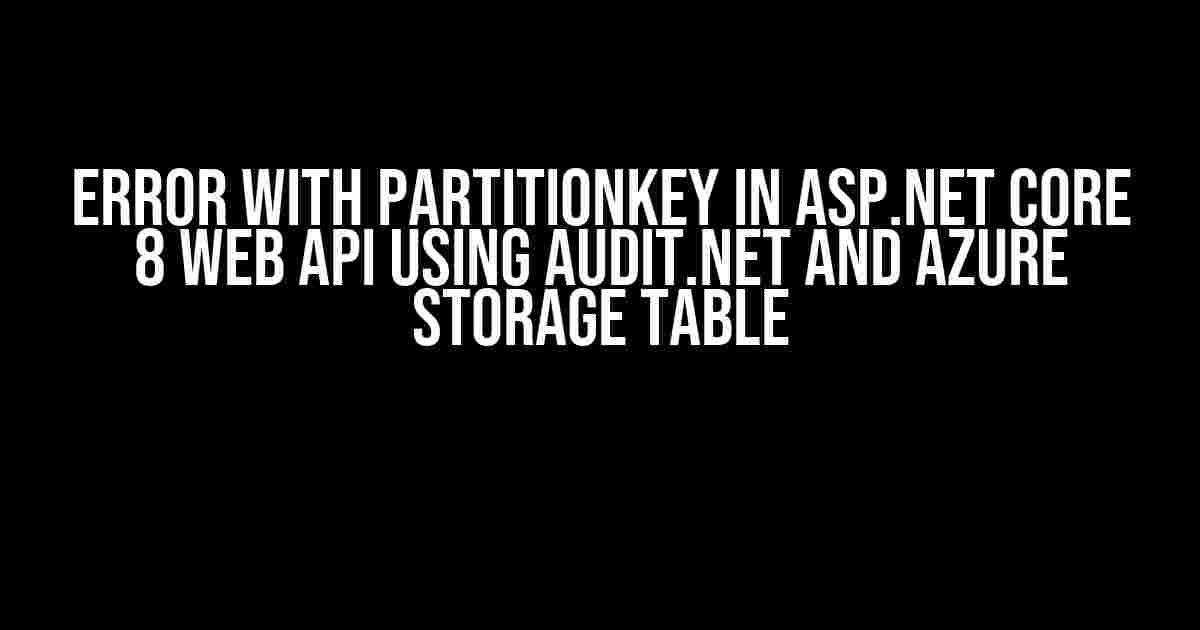Are you stuck with the infamous “Error with PartitionKey” issue while trying to integrate Audit.NET with Azure Storage Table in your ASP.NET Core 8 Web API? Well, you’re not alone! In this article, we’ll dive deep into the world of auditing and storage tables to help you resolve this pesky error and get your application up and running smoothly.
Understanding the Basics
Before we dive into the error resolution, let’s quickly recap the basics. Audit.NET is a popular auditing library for .NET that helps you track changes to your data. Azure Storage Table, on the other hand, is a NoSQL database service offered by Microsoft Azure. It’s a great choice for storing large amounts of data, especially when you need to query it efficiently.
Audit.NET Configuration
To use Audit.NET with Azure Storage Table, you need to configure it correctly. Here’s an example of how you can do it:
<audits>
<audit event-type="On">
<provider>
<type>Audit.AzureStorageTable></type>
<config>
<account><account_name></account>
<key><account_key></key>
<tableName><my_audit_table></tableName>
</config>
</provider>
</audit>
</audits>
In the above configuration, we’re telling Audit.NET to use the Azure Storage Table provider and specifying the account name, key, and table name.
The Error: PartitionKey Not Found
Now, let’s get to the error that’s causing you so much trouble. When you try to write an audit event to the Azure Storage Table, you might encounter the following error:
Error with PartitionKey: 'PartitionKey' property is missing or empty.
This error occurs because the PartitionKey property is not being set correctly. But don’t worry, we’ll show you how to fix it!
Resolving the Error
To resolve the error, you need to ensure that the PartitionKey property is set correctly. Here are a few ways to do it:
Method 1: Using the AuditEvent
You can set the PartitionKey property directly on the AuditEvent object:
var auditEvent = new AuditEvent();
auditEvent.PartitionKey = "my_partition_key";
Audit.Core.Configuration.AuditEnabled = true;
Audit.Core.Configuration.Setup()
.UseAzureStorageTable(_ => _
.WithTableName("my_audit_table")
.WithPartitionKey(auditEvent.PartitionKey));
Method 2: Using the Azure Storage Table Configuration
You can also set the PartitionKey property in the Azure Storage Table configuration:
Audit.Core.Configuration.Setup()
.UseAzureStorageTable(_ => _
.WithTableName("my_audit_table")
.WithPartitionKey("my_partition_key"));
Method 3: Using a Custom Provider
If you’re using a custom provider, you can override the GetPartitionKey method to set the PartitionKey property:
public class CustomAzureStorageTableProvider : AzureStorageTableProvider
{
public override string GetPartitionKey(AuditEvent auditEvent)
{
return "my_partition_key";
}
}
Remember to register your custom provider in the Audit.NET configuration:
Audit.Core.Configuration.Setup()
.UseAzureStorageTable(_ => _
.WithTableName("my_audit_table")
.WithProvider<CustomAzureStorageTableProvider>());
Additional Troubleshooting Tips
If you’re still encountering issues, here are some additional troubleshooting tips to help you resolve the error:
- Check your Azure Storage Table configuration**: Make sure that your table name, account name, and account key are correct.
- Verify the PartitionKey property**: Ensure that the PartitionKey property is being set correctly and is not null or empty.
- Check for typos**: Double-check your code for any typos or syntax errors.
- Use the Azure Storage Explorer**: Use the Azure Storage Explorer to verify that your table exists and that you have the correct permissions.
- Enable auditing for specific events**: Try enabling auditing for specific events to see if the issue is related to a particular event type.
Conclusion
Error with PartitionKey in ASP.NET Core 8 Web API using Audit.NET and Azure Storage Table can be frustrating, but with the right guidance, you can resolve it easily. By following the steps outlined in this article, you should be able to set the PartitionKey property correctly and start writing audit events to your Azure Storage Table.
Remember to troubleshoot carefully and methodically, and don’t hesitate to reach out if you have any further questions or issues. Happy coding!
| Audit.NET Version | Azure Storage Table Version | ASP.NET Core Version |
|---|---|---|
| 6.4.0 | 12.1.0 | 8.0.0 |
Note: The versions mentioned above are for reference purposes only and may not be compatible with your specific environment.
Frequently Asked Question
Get the answers to the most commonly asked questions about error with PartitionKey in ASP.NET Core 8 Web API using Audit.NET and Azure Storage Table.
What is the purpose of PartitionKey in Azure Storage Table?
PartitionKey is used to distribute data across multiple servers in Azure Storage Table. It helps to scale and optimize the performance of the table by allowing it to handle a large amount of data. In the context of ASP.NET Core 8 Web API, PartitionKey is used to store audit logs using Audit.NET.
Why am I getting an error with PartitionKey when using Audit.NET with Azure Storage Table?
The error with PartitionKey often occurs when the PartitionKey is not set or is set incorrectly. Make sure to set a valid PartitionKey in your Azure Storage Table configuration. Also, ensure that the PartitionKey is in a valid format and does not exceed the maximum length allowed by Azure Storage Table.
How do I set the PartitionKey in ASP.NET Core 8 Web API using Audit.NET and Azure Storage Table?
To set the PartitionKey, you need to configure the Azure Storage Table provider in your ASP.NET Core 8 Web API project. You can do this by creating a new instance of the TableStorageDataProvider and setting the PartitionKey property. For example, provider.PartitionKey = "MyPartitionKey";.
Can I use a dynamic PartitionKey in ASP.NET Core 8 Web API using Audit.NET and Azure Storage Table?
Yes, you can use a dynamic PartitionKey in ASP.NET Core 8 Web API using Audit.NET and Azure Storage Table. You can achieve this by implementing a custom PartitionKey resolver that returns a dynamic value based on your requirements. For example, you can use the current date or a unique identifier as the PartitionKey.
How do I troubleshoot errors with PartitionKey in ASP.NET Core 8 Web API using Audit.NET and Azure Storage Table?
To troubleshoot errors with PartitionKey, enable logging and debugging in your ASP.NET Core 8 Web API project. Check the log files for any error messages related to PartitionKey. Also, verify that the PartitionKey is set correctly in your Azure Storage Table configuration. You can also use tools like Azure Storage Explorer to verify the PartitionKey and table structure.

